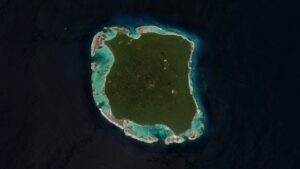There is sad news from Nepal, where a rescue helicopter spotted Nadya Oleneva’s body on Sunday morning.
As we reported on Saturday, Oleneva, Roman Abildaev, and Rasim Kashapov were attempting to climb 8,167m Dhaulagiri I. The three mountaineers were climbing without sherpa support or supplementary oxygen. After acclimatizing over a few days, they knew the route well.

Nadya Oleneva. Photo: Masha Gordon
The climb and the accident
Early Saturday morning, they started the ascent from Camp 1. After four hours, Abildaev arrived at 6,680m Camp 2. Three minutes later, Kashapov arrived and they waited for Oleneva. According to mountain.ru, there was no sign of Oleneva, so Kashapov went back to see where she was.
The two men found her hiking pole and evidence that she had slid down the slope. They followed the trail down for 200m before it ended in seracs and the icefall became steeper. Cloud moved in, and Kashapov and Abildaev had to descend to Base Camp, arriving by nightfall.
They held out hope that maybe Oleneva had somehow slowed down and, with her sleeping bag and first aid kit, maybe she could have survived the fall. Unfortunately, this was not the case.

From left to right: Evgeny Glazunov, Pavel Tkachenko, and Nadya Oleneva in 2019. Photo: Evgeny Glazunov
Oleneva’s legacy
Thirty-eight-year-old Nadya Oleneva was one of Russia’s best women climbers. She was a mountaineering instructor and a highly experienced alpinist who made several technically difficult ascents during her career.
She was nominated twice for the Piolet d’Or and was a recipient of the 2021 GRIT&ROCK grant.
We detail a few of her outstanding expeditions below.
Siberia, 2019
In July 2019, Oleneva, Evgeny Glazunov, and Pavel Tkachenko traveled to the Bauntovsky region in the Russian Far East. The expedition was organized to honor Glazunov’s younger brother, Sergey, who was killed on Latok I in 2018.
They headed to the South Muysky Ridge, a range of granite peaks. The highest peak, Muysky Giant (3,067m), located in the northeastern part of the range, had seen several ascents. Yet the southwestern part (some 125km from the Giant) was little known to rock climbers.
The trio targeted the southwestern section. To get there they had to trek a long way, crossing four passes. After scouting the area, they climbed three walls. On each of the routes, 95% of the climbing was free, according to the American Alpine Journal. They also made several first ascents of the peaks.

The 700m route on the west face of Pik Kart is one of the several ascents made on the 2019 expedition. Photo: Evgeny Glazunov
First ascent of Sharp Peak in Kyrgyzstan, 2021
In the summer of 2021, together with partners Maria Dupina and Marina Popova, she targeted one of the unclimbed peaks in the Orto-Chashma Gorge of Kyrgyzstan’s Pamir Alai.
The 4,818m “beautiful granite needle,” as Oleneva described it, had caught their attention in a photo taken by trekkers. The trio attacked the climb from right under the wall of the peak, by the glacier. They spent several days carrying loads to this camp. “After looking at various options, we decided to climb the steep east ridge,” recalled Oleneva.

Photo-topo of the first ascent of Sharp Peak, 2021. Photo: Oleneva Collection
On August 4, they left camp at 4:30 am and climbed up on very difficult terrain, in bad weather, and on wet rock. They intended to free climb the route, but on one 50m section, they had to use aid. No bolts were placed.
On top of the steep east ridge, they put up a tent and spent the night. The next day they topped out. The route’s difficulty was Russian 5B UIAA VII+ A3, and the total length, including the summit ridge, was 1,020m. According to Oleneva, in good weather, they would have been able to free-climb the entire route.
They named the mountain Pik Ostryi, “Sharp Peak.”

The Oleneva-Mukhametzyanov-Parfenov route (marked with the number 1) on the north face of Pik Korolyova. Photo: Oleneva Collection
Tien Shan, 2022
Oleneva’s expedition to the Tien Shan in Kyrgyzstan in the summer of 2022 was a masterpiece.
In July of that year, Oleneva, Ratmir Mukhametzyanov, and Alexander Parfenov made the first ascent of the main north face of 5,816m Pik Korolyova. On the first day, the trio climbed about 700m vertically, with 450m of steep, sometimes vertical, ice that had a more porous structure than glacier ice.
The second day, they climbed 380m and set up camp on a small, steeply sloping shelf. “Stomping down the snow so we could put up our tent took about two hours and even after all this effort, one-third of the tent still hung over the void,” Oleneva wrote in her report.

Nadya Oleneva. Photo: Masha Gordon
On the third day, they climbed a second rock bastion with 250m of mixed climbing. Before reaching the northwest ridge, the three climbers had to slog through 200m of deep snow without a proper belay. Finally, on July 22, at 3:20 pm they topped out.
They spent the night on the ridge and descended to base camp, arriving there at 10 pm. Every day during the ascent, they swapped leads. “Each of us was able to enjoy the ascent of the stunning north face of Korolyova,” Oleneva said.






